Do you see this? It is a John Deere Parts and Merchandise Adviser from 1981 (Photo 1). It is full of John Deere service parts, tools and other items that a dealer’s customer might be interested in. This issue is for agricultural dealers and guess what? It is not what we will be looking at today.
THIS is what we will be paging through this time. It is a 1967 John Deere industrial parts flyer. Early issues are rare and industrial versions even more so. Remember, Deere’s Industrial Division wasn’t all that old in 1967 and I think this is the only industrial issue I have. A model 350 crawler graces the cover and, although this model is old by today’s standards, there are still many of them in use across the country (Photo 2).
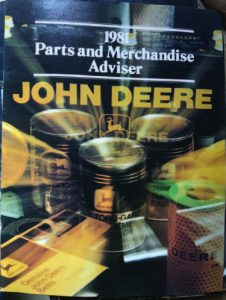
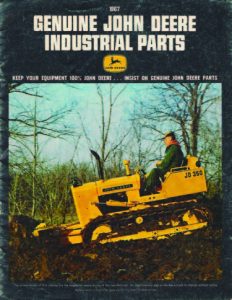
At the top left on Photo 3, Deere makes its case for why customers should buy genuine John Deere parts. The standard “parts designed by skilled engineers,” “parts made of high quality materials,” “made with modern precision manufacturing methods” and “parts must pass rigid quality inspections” reasons are all listed. Below that, Deere explains that this booklet is to be used by customers to check their equipment for necessary parts and to make lists of required items.
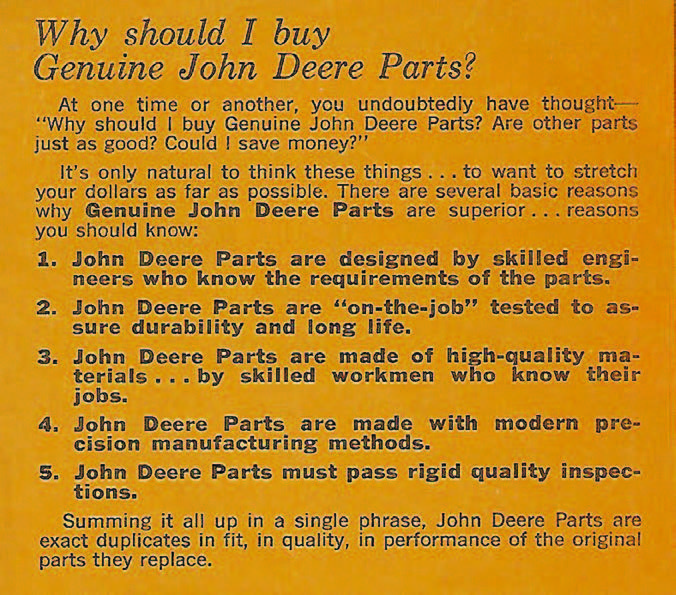
Below this is a new item from Deere in 1967—a tractor radio. The part number was AR40947 and in 1967 you could have bought one for $79.40. That would be somewhere around $600 or so in today’s money. For an AM radio? Even if it was waterproof and had a snazzy chrome springy antennae, I don’t think so. Of course, it is hard to say what this radio today would be worth as a collector’s item. I suspect if it was in good appearing condition, it might bring $300. A new one in the box might even approach the $600, so I guess it’s all a matter of degree and you know the world of collecting! Interesting how much less money radios are today and of course with features that would never even have been dreamt of in 1967. To the right of this is the index to what is inside this flyer.
Photo 4 is the first page in the flyer. Listed at the top are some of the mufflers offered by Deere in 1967. First up is part AT10646 and it is a muffler for models 440 and 1010 gas tractors. I knew this part was still available today as I have sold many of them over the years. In 1967, it was $9.22 and today it will cost you $69.30. Running this through the inflation calculator, it is dead on with $69.32 being what the $9.22 would be in today’s dollars.
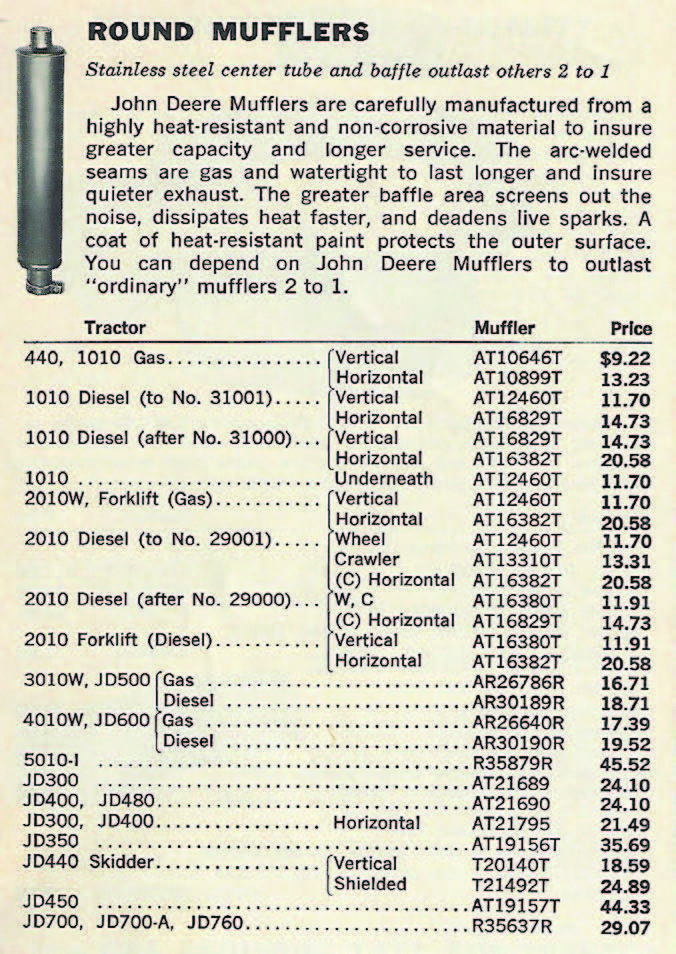
Below this are listed mufflers for the 1010 diesel, 2010 gas and diesel and most of these are obsolete from Deere. There are, however, mufflers available in the aftermarket, so all hope is not lost. The 3010 and 500 gas have a muffler (part number AR26786) listed. In 1967, it was $16.71 and today it is still available and lists for $66.39 from Deere. This one beats the inflation calculator; it says the $16.71 should be $125.63 but looks like Deere has held the line on this one!
Below this is a very interesting section—the listings for cast muffler covers or muffler weather caps. These were made of cast aluminum and quite some time ago now, Deere replaced them with the common stamped steel versions. Collectors search for these original style cast covers as they are period correct and are a great accessory for a vintage tractor. Many years ago, I wrote an article for Green Magazine on these covers as I had many of them in stock. I sold most of them on eBay during the nine years I was selling there and they did quite well as they were new old stock covers. They turn up from time to time and bring a fair amount. Since mufflers are different sizes, there were quite a few different caps made—an interesting segment in Deere’s history for sure.
On the right are listed oval mufflers, which in my days as a dealer were still available but which appear to all be obsolete from Deere today. Below this are oil filters, most of which you can still buy from Deere, and the AB4748R pulley brake lining with adapter that is still so popular with two cylinder collectors. Instead of disassembling your pulley brake to install a new brake pad, this handy part allowed you to just clip on a replacement pad. Price of $1.07 in 1967, today it is $20.97 from Deere. Again, aftermarket options are available.
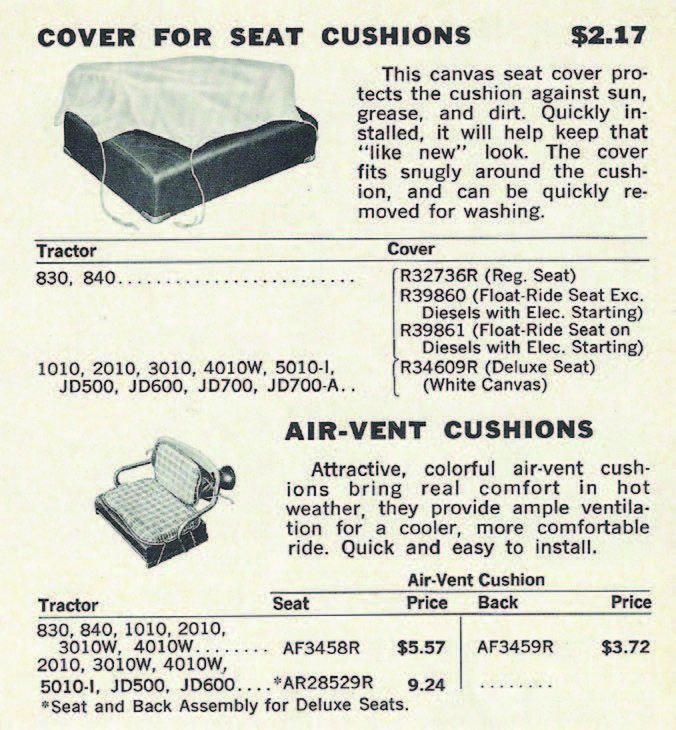
Photo 5 is all about seats and covers with a dash of radiator and fuel caps thrown in. Many of these are still available from Deere, although their construction has changed over the years and some are obsolete. The aftermarket has this area covered thoroughly though. At the top right is listed seat covers. These were used to cover a damaged seat or to protect a new one. These are all obsolete, although I’ve got a few different ones. The ones I remember are made of a white material and this has always made me wonder “Why white”? It sure seems like a poor choice to me to use on a machine that is being used to work in fields and construction sites. It seems like it would instantly get dirty. No idea why Deere chose white on this one.
Below this are the Air-Vent cushions. These allowed air to circulate and were made of a multi-colored open weave material. These are rarely seen today and are an interesting option for a restored tractor. I’ve got a few of these new old stock and I always liked the red edging and white, black and gray material they are made from—a neat upgrade for a restored tractor for sure. The fuel and radiator caps are mostly still available from Deere or the aftermarket, although on a few there are construction differences that are noticeable on a restored tractor.
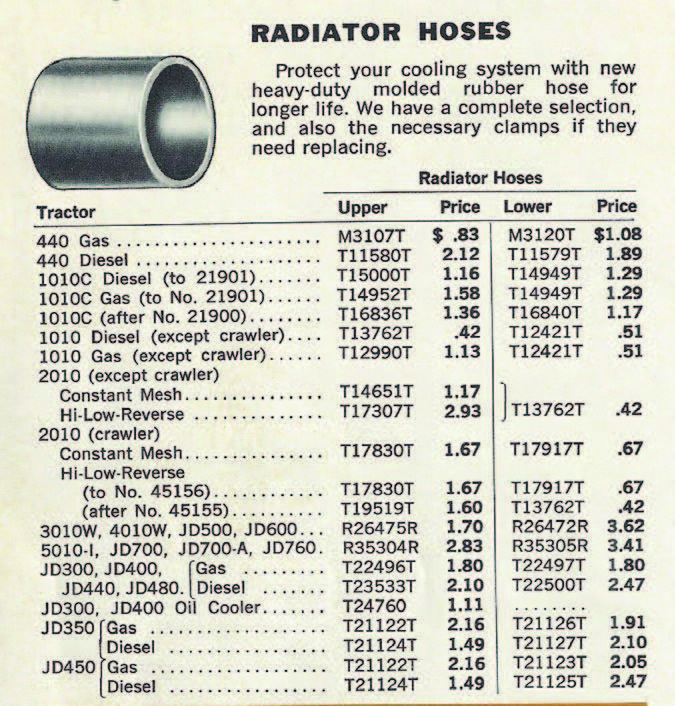
Photo 6 deals with radiator hoses, oils and conditioners and gasket sets. There are many interesting things going on with these old parts too, no matter what it may seem at first glance. The old new old stock radiator hoses I had were worth looking at. I had no idea until I inspected them that the replacement hoses had John Deere part numbers stamped on them in white ink. This would be a neat touch on a restored tractor, although vintage NOS hoses are very rare today. I had a few for the model “L,” “R,” “A” and “B” tractors and all carried the part numbers on them. The gasket sets have all had their part numbers changed due to Deere’s asbestos campaign in the late 1990s or early 2000s. Another major tractor manufacturer had been hit with a lawsuit over the asbestos contained in the old gaskets. Deere went into preemptive mode and gathered all existing stock of the old gaskets, changed part numbers and I assume composition and reissued them. Deere chose to deal with this problem first before being made to by the courts. This is one reason why all the old two cylinder and New Generation gaskets sets changed part numbers. Of course, I “couldn’t find mine” when contacted by Deere and kept the ones I had as I was interested in them as being new old stock parts rather than as something to use.
Also, I have a few early engine overhaul sets that are quite attractive in their packaging. One I have for a model 5010 has a yellow cardboard backing and a cellophane or plastic covering. This leaves the great old six cylinder copper clad head gasket out in full view. I have had it and a few others for many years and really like this packaging. I’ll share pictures at some future point.
Also listed are various John Deere Special-Purpose oils, power steering oil and engine coolant conditioner. All of these have changed part numbers numerous times and today Special-Purpose oil is known as Hy- Gard oil. The neat thing about these is that today the cans are quite collectible. Many collectors have a shelf or two or three or…you get the picture…with these old cans proudly displayed and rare ones can command high prices, especially if in good condition.
Photo 7 is all about engine parts. Some of you may been wondering about the tractors that are listed and have parts shown. Why the 440? 1010?
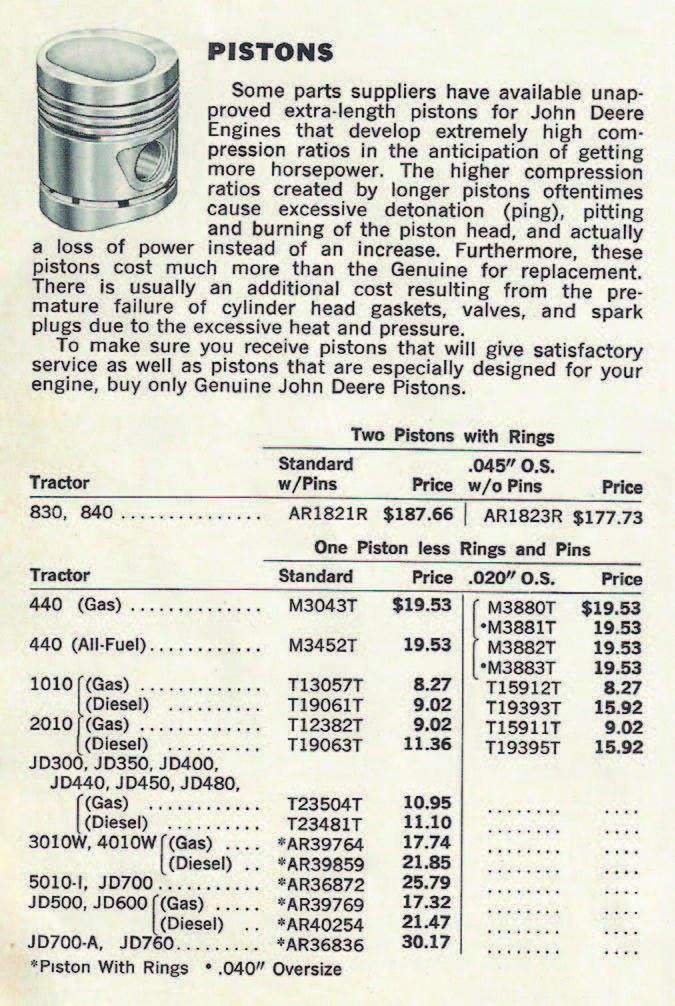
No model “A” or “B”? And if not those two cylinder tractors, why in the world is the 830 listed? That is because this is an industrial catalog and the letter series did not have an acknowledged industrial purpose. The 830 is listed as there was an 830 industrial version and of course the 840 is simply an 830 in belly scraper clothing.
At the top are listed engine valves, springs and valve locks. The valves are mostly still available from Deere except for the two cylinder 830; they are obsolete. Also, part T12356, intake valve for 1010 and 2010 gas tractors, is down to only two solitary individuals in stock at Deere. Next stop—obsolescence and so the story goes.
The pistons are listed below the valves and it’s the same story. Most are available except for the two cylinder tractors; they are obsolete. Quick side story—some of you may remember an article I wrote years ago about me being approached by Deere to buy some obsolete parts overstock. To sum it up, I ended up with several hundred new John Deere pistons that were surplus to their needs. One of these was part AR1823R, .045 oversize piston for model 830 tractors. Needless to say, I sold pistons and lots of them as the pricing was quite a discount over normal retail. Included in this deal were new 730 diesel flywheels, model C Wico magneto caps and many other parts. We literally had a semi pull up to the dealership to unload the parts I had purchased. It was a blast, let me tell you. It was good to kind of run through these engine parts to see what is still available as I haven’t done that for many years. It seems like it boils down to—two cylinder parts not available, everything else is a maybe. So, it is best to check.
Photo 8 covers battery cables at the top. Most original part number cables are long gone, so to do a restoration, it will likely be necessary to have cables copied and made to original specifications. What I was really interested on this page is in the lower left-hand corner. Cigarette lighters. That’s right, lighters. Original lighters are almost impossible to locate today and, although I had quite a few at one time, they left during my time on eBay. There are a few available today that are close but not all styles can be had. In the very bottom corner is one of my favorites—starting fluid. This is one part number that I don’t think I will ever forget, AR27814. It is still available today, but the part number is on its fifth revision.
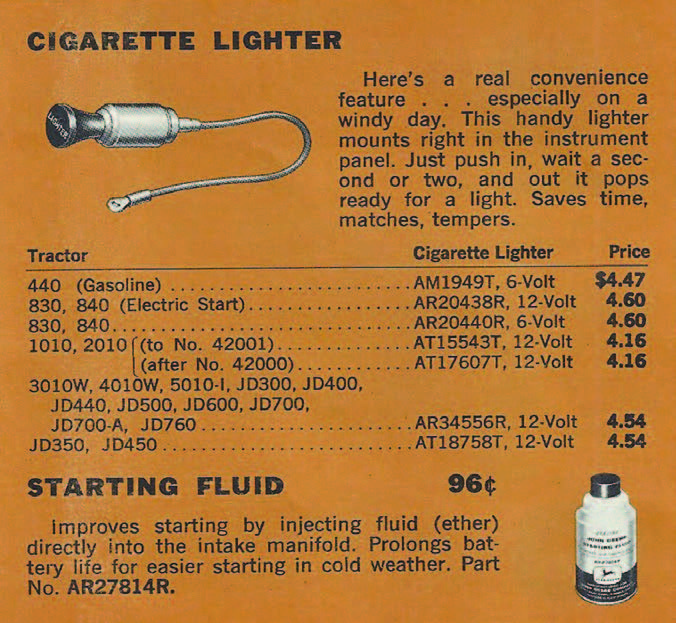
The other item that caught my eye is in the lower right-hand corner, John Deere batteries. I think at that time, the batteries would have been supplied by Prestolite but I’m not entirely sure. When is the last time you saw a battery with a four-legged deer logo on it like the one in the picture? I am kind of surprised that no one has produced a reproduction battery for John Deere tractors. In the car world, I can buy a reproduction Autolite battery if I want one to use in my restoration. It seems like this would have been taken care of by now, but it has not so far as I am aware. I’ve never seen an old junk battery like this either although I looked for years.
Photo 9 shows the various products that were available to provide comfort and protection for the operator of these industrial machines. At the top are umbrellas and sunshades. The umbrella is part TY2006 and it is still available today under the new part number TY2035. TY2006 was a four-legged deer logo umbrella so, of course, it is no longer available. Part TY2035 is an older part number but is still offered, although it has the new style logo on it. The TY2014 fender mount sunshade is still available, although it too has been updated. The balance of the pages talk about weather brakes, shields, cabs, canopies and windshields for industrial models. I hadn’t really thought about it, but construction work must go on, rain or shine, so some form of operator protection would go a long way to ensuring that the machine stayed working. Happy operator, happy machine.
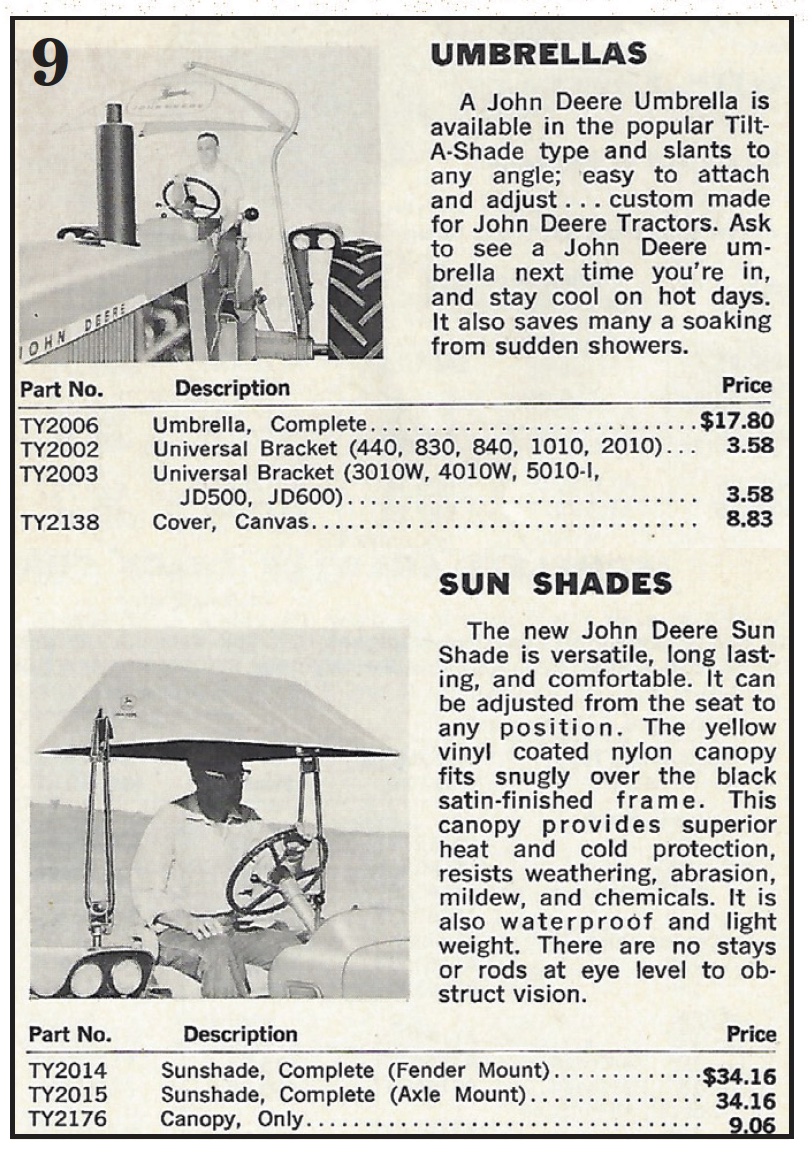
In the lower right corner is a Roll-Gard with seat belts and canopy. Now where I have seen this canopy recently…might it be in someone’s rafters in a warehouse somewhere?
Photo 10 is all about crawlers. When I hear the words “industrial machine,” I immediately think “crawlers” and then “backhoes.” Here are listed all of the different crawler track pads that were offered in 1967. A few of these shoes are still available although under a new updated part numbers. The ones I was interested in, however, were the rubber track pads. Back when I was restoring my Lindeman, I decided I wanted to put it on rubber track pads. I had an NOS set of steel pads but wanted rubber so I could move it on pavement and in our showroom, etcetera. I got busy and started hunting down rubber pads from Deere. I would have only been able to come up with half a set back in the early 1990s so I gave up. I do still have one NOS rubber tack pad, however, as I ordered it to be sure I could make it work. We eventually came up with another solution for the “BO” Lindeman but that’s a story for another time.
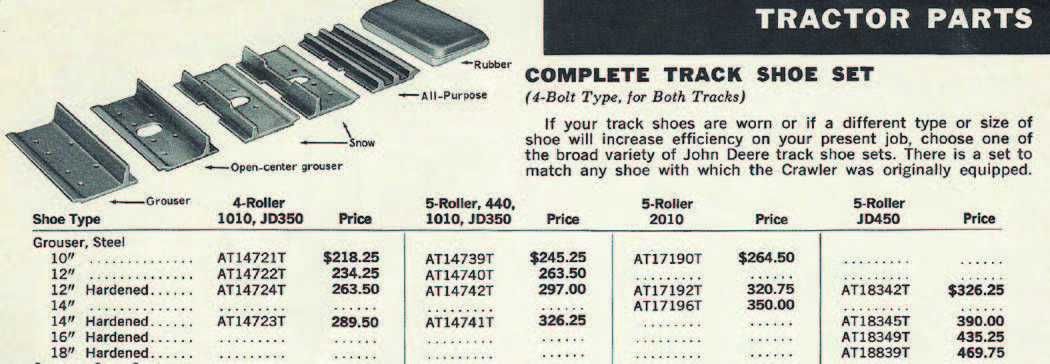
The knobs in Photo 11 caught my eye. I have a few different NOS knobs and I know some are obsolete and some are not. I had no idea there were this many though—looks different all laid out together. Deere still offers M884T, the knob or grip for the steering handles on a 440 crawler and an “M” crawler. However, they are priced at $89.10 so that is clearly not an option. The last list price I have on this part, probably around the early 2000s, was $17.75, quite an increase. A lot of these knobs are obsolete, although the ones that are available don’t appear to suffer from the same pricing problem that M884T does. I have a few of these obsolete knobs still in stock, depends on the part number mostly.
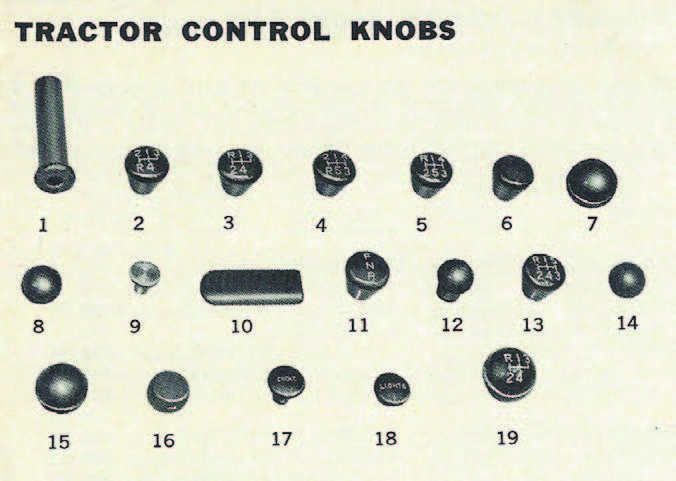
At the top are rollers and bushings. Some rollers are obsolete, while others are available though an industrial dealer. Looks like bushings are available though. At the bottom right is a section on winches, fairleads and log arches. That winch looks very familiar; seems like I know someone that has a brand new one lying around.
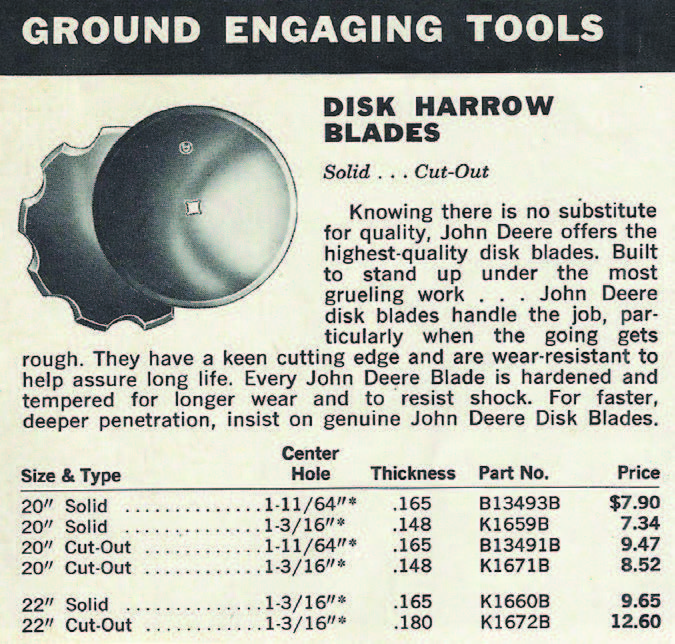
Disk blades are listed in Photo 12 as disks were a useful tool in construction— the same with the spring tooth harrow teeth. On the right-hand side are listed parts for sickle mowers, another piece of equipment used both in agricultural and industrial operations. Over the years, I sold a lot of parts for Deere sickle mowers. As I have a lot of new old stock parts for early mowers, I often get involved in supplying parts for restorations. I remember one time a fellow needed a new gear for a gear box on a No. 2 sickle mower as well as other parts that were missing. I had everything he needed including a new sickle. I was proud of that one. It’s interesting to me how the part numbers have changed on sickle mower parts over the years while the basic machine hasn’t. Old parts fit newer machines with no problem. I guess once you have something that works, why change it, right? Many of these parts are still available, although under new numbers. The guards, for example, can still be purchased from Deere but they look nothing like the guards that were used back in the day. This isn’t a big deal if you’re using the mower, but for someone restoring a mower, it can be a game changer. Original style guards are very difficult to locate today.

More mower parts are listed in Photo 13. Most of these are also still available under newer part numbers as they are necessary to be able to keep cutting with the mower. Items like the grass board shown, however, are not although there are alternatives. The item in the lower right-hand corner is one of my favorites. It is the sickle mower guard and knife repair block. These were in almost every dealer’s shop at one time and many farmers also. There have been various versions made over the years and they have become collectible. I remember years ago, in one of our bolt bins in the shop, down low there was one of these. I didn’t know what it was when I first saw it but later liberated it from under all the junk lying on top of it. I still have it to this day as well as one or two new old stock repair blocks. A neat item.
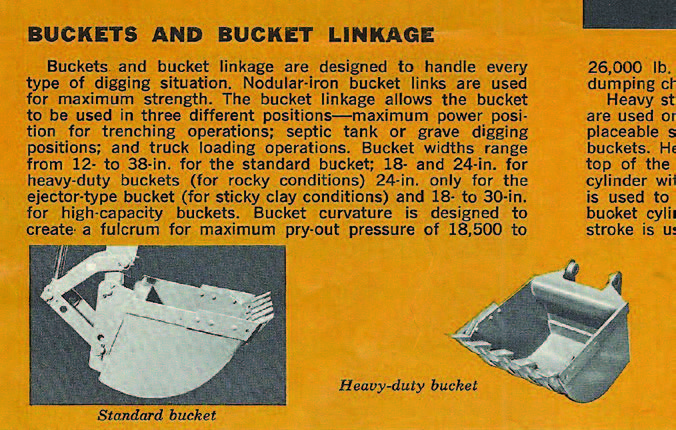
Crawlers and backhoes, right? We saw a page of crawler parts and now here’s the backhoe parts (Photo 14). Buckets, cutting edges and pins are all listed. They were needed back then and these are still the parts we get calls for today. I had forgotten to call your attention to the neat logo down in the lower left-hand corner of this page; it is used throughout this booklet and it is neat to see this old logo in the black and industrial yellow colors. Some of these parts are available today, but various pins and edges are not and substitutes would have to be located. The backhoe seats are also long gone.

More knobs! Many are the same as on the earlier page so why they are repeated here, I have no idea (Photo 15). I still like knobs so it’s all good to me. Hydraulic filters are listed but what caught my eye are the items at the bottom of the page. On the left is Loctite sealant. Sealant, in the various cans and tubes it has come in, was at one time identified with John Deere wording and logos. As I mentioned in an earlier article, Deere has mostly discontinued this and today supplies sealants only in standard Loctite packing without Deere identification. For this reason, sealant and other chemicals, in John Deere packaging, have become quite collectible also. Sometimes I just stop and think, “Boy, this has really gotten crazy, hasn’t it?” It seems like all the service items Deere produced over the years are now collectible. The same has happened with International Harvester items. My suggestion to you is to go out to your shop or building and scrounge to see what you might uncover. A half-used can of gasket sealer or an old water jug or anything with an old logo or John Deere wording might be just what someone is looking for.
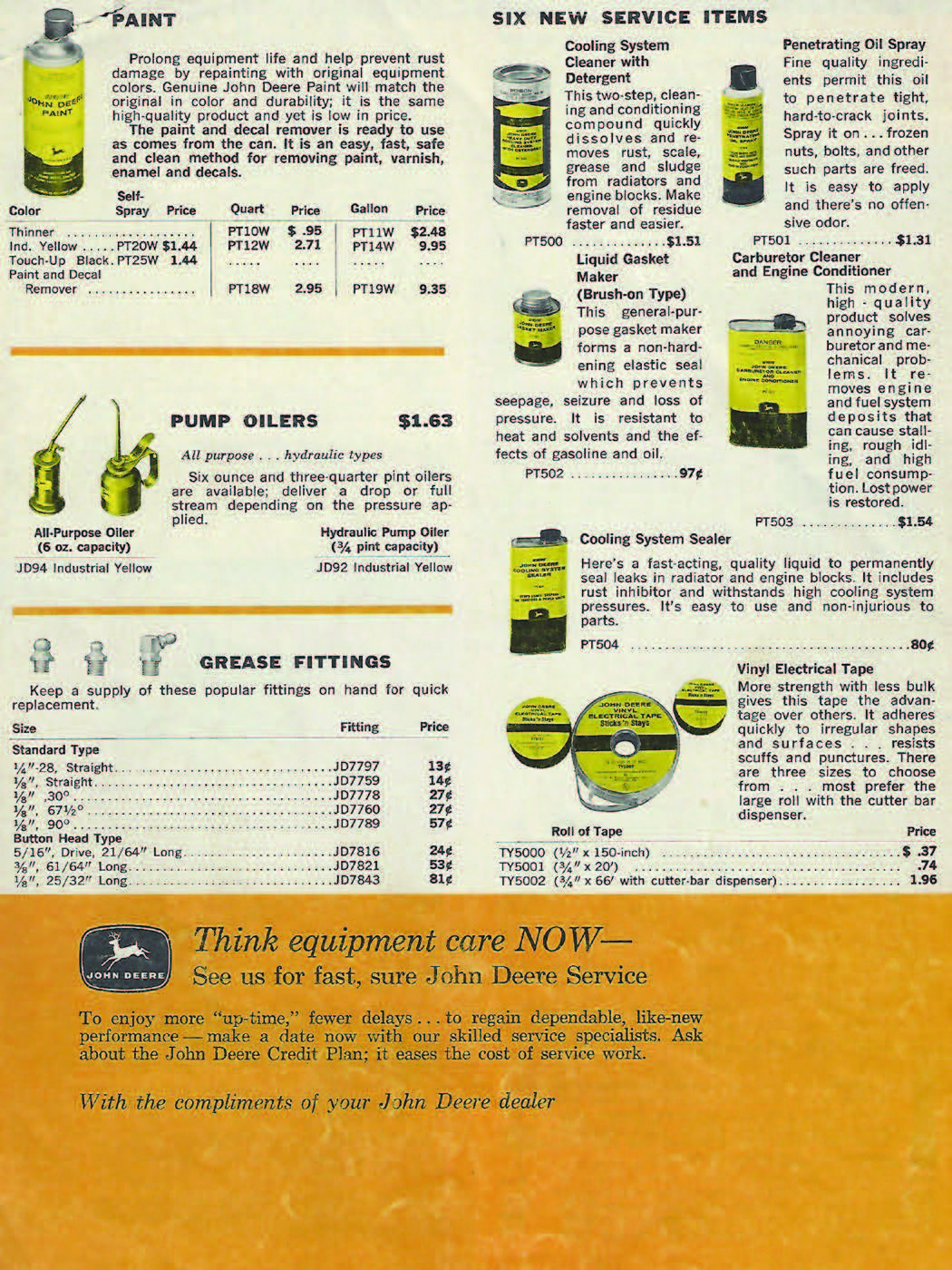
The other item is in the righthand corner and it is the John Deere tire pump. If you aren’t familiar with these, this is a tire pump that attached to the PTO of your tractor and when the PTO was engaged, the pump produced air for taking care of low tires on the farm. They are still handy to this day but have been collectible for some time as there were different versions made over the years. It looks like in 1967, you could still buy a brand new one in the box. I have a new one in the box too somewhere put away.
Photo 16 is the back cover of this parts booklet. Paint, penetrating oil, gasket maker, carburetor cleaner, electrical tape and more were all offered. Every single one of these items in this packaging is today collectible. Items like this were bought to be used and most were and then thrown away. That is what makes any surviving examples so difficult to locate today. Deere concludes this booklet by telling the customer to “Think Equipment Care Now!” Space for a dealer imprint is at the bottom, although this one does not have one. My other agricultural booklets mostly do have a dealer’s name and address on them. The ones we handed out or mailed out had our dealership name on them and I have a few somewhere.
I like books like this as they contain so much information in a small package. Deere chose commonly needed parts and fast movers to get them in front of the customers. Looking through an old catalog like this is like taking a walk back in time. Some of this stuff is a bit early for me as we bought our dealership in 1967 but it was around and how I wish I had saved everything I saw. But you know how that goes. Whatever you save and are sure will be worth something in the future turns out to be not quite what is being sought after. Ultimately you usually come close, but fail to make a score. Not always, but often enough.
Personally, I like the old service items a lot and I keep uncovering a few here and there. I know somewhere I have a bunch of spray paint and all of them will be in now discontinued packaging as they carry the older twolegged logo. This means there will likely be collectors interested in picking up a few and I certainly don’t need five or six of each so I plan on selling the spares I come up with. It is hard for me to understand how items that are only 20 or 30 years old can be so darn hard to find today. It drives me crazy. Every dealer in the country, and there were a whole bunch more of them back then, had these items. Today try to find an old roll of electrical tape—it’s nearly impossible. There are collectors who have showcases full of items like this and they are very interesting to see. It points to the sheer volume of products Deere has produced during the past nearly 200 years. It is staggering. Nearly every day, it seems like something new turns up. That is what keeps everyone collecting and interested in this hobby, of this I am sure. Until next time!
